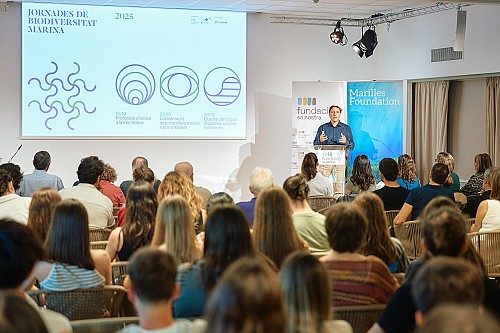Marilles joins forces with other organisations to improve the conservation of shallow water bays
Published 04.06.2024
Share

Improving the conservation status of Menorca's shallow water bays is the main objective of the Conservation and restoration of shallow water bays project presented 4 June by the Socio-Environmental Observatory of Menorca-Menorcan Institute of Studies (OBSAM-IME), Marilles Foundation, Menorca Preservation, and the Blanes Centre for Advanced Studies-Spanish National Research Council (CEAB-CSIC) during an event held in Cala Teulera (Maó). In addition to defining the current state of these bays and promoting conservation and restoration plans, two main objectives are to raise public awareness of the ecological importance of these habitats and to get the authorities involved in their conservation.
The bays studied so far have been Addaia, Fornells, and Maó, but work with other bays is possible in the future.
Actions carried out
This is the second phase of a larger project that was launched in 2022. OBSAM has been responsible for defining the conservation status of these bays and designing a programme for their recovery. It has also conducted active restoration tests on Gongolaria barbata, a species of algae of the genus Cystoseira s.l., in Cala Rata and Addaia and, in parallel, the population restored in previous years in Cala Teulera has been maintained.
Specifically, conservation and restoration plans have been drawn up for Addaia Bay and Fornells Bay. As for the Bay of Maó, the initial diagnosis has been carried out and management measures are being drafted. The data on the population of the invasive pearl oyster (Pinctada radiata) in the three bays has also been updated. Part of the project experience has also been used to feed the IME study of the ecological carrying capacity of Fornells Bay commissioned by the government of the Balearic Islands in 2023. In addition, temperature sensors have been installed in the restoration areas of the three bays.
The project has benefitted from the scientific advice of Emma Cebrian and Enric Ballesteros from CEAB-CSIC, especially for the scientific-technical actions to be developed.
Next step
The next step will be to validate the conservation and restoration plans with staff from the administration and the community. Workshops and colloquiums will be organised to publicise the plans and gather the opinion of the people linked to these spaces on new measures and whether to validate the proposals.
In the same direction, Menorca Preservation and Marilles Foundation, with technical support from OBSAM-IME, have created the communication campaign Dive into the bays, to bring the richness of these marine environments to the population. The campaign will be launched in the coming weeks through their social networks and will focus on disseminating the most curious and interesting aspects of these incredible marine habitats. What is a shallow water bay? Why it is so important to preserve these environments? What species inhabit them? These are some of the questions that will be answered through this campaign, which will last until the end of October.
A deteriorated space
Menorca's shallow water bays are home to many unique habitats and species. However, many pressures such as poor water quality, the impact of shipping, and coastal development pose a serious threat to them. They have been considerably degraded in recent decades. The surface area of marine plants such as Posidonia or Cymodocea,algae of great ecological value such as Cystoseira, and emblematic species such as seahorses have decreased significantly in their waters.




